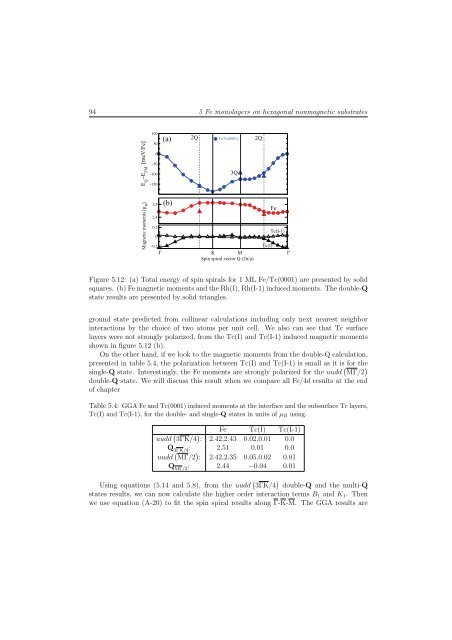Ab initio investigations of magnetic properties of ultrathin transition ...
Ab initio investigations of magnetic properties of ultrathin transition ...
Ab initio investigations of magnetic properties of ultrathin transition ...
Create successful ePaper yourself
Turn your PDF publications into a flip-book with our unique Google optimized e-Paper software.
94 5 Fe monolayers on hexagonal non<strong>magnetic</strong> substrates<br />
E Q −E FM [meV/Fe]<br />
Magnetic moments [μ B ]<br />
100<br />
50<br />
0<br />
−50<br />
−100<br />
−150<br />
2Q Fe/Tc(0001) 2Q<br />
0 0.5 1 1.5<br />
2.5<br />
2.4<br />
(a)<br />
(b)<br />
0.2<br />
0<br />
0<br />
0.2 0.4 0.6 0.8 1 1.2 1.4<br />
Tc(I-1)<br />
−0.2<br />
Tc(I)<br />
⎯Γ ⎯Κ ⎯Μ ⎯Γ<br />
Spin spiral vector Q (2π/a)<br />
Figure 5.12: (a) Total energy <strong>of</strong> spin spirals for 1 ML Fe/Tc(0001) are presented by solid<br />
squares. (b) Fe <strong>magnetic</strong> moments and the Rh(I), Rh(I-1) induced moments. The double-Q<br />
state results are presented by solid triangles.<br />
ground state predicted from collinear calculations including only next nearest neighbor<br />
interactions by the choice <strong>of</strong> two atoms per unit cell. We also can see that Tc surface<br />
layers were not strongly polarized, from the Tc(I) and Tc(I-1) induced <strong>magnetic</strong> moments<br />
shown in figure 5.12 (b).<br />
On the other hand, if we look to the <strong>magnetic</strong> moments from the double-Q calculation,<br />
presented in table 5.4, the polarization between Tc(I) and Tc(I-1) is small as it is for the<br />
single-Q state. Interestingly, the Fe moments are strongly polarized for the uudd � MΓ/2 �<br />
double-Q state. We will discuss this result when we compare all Fe/4d results at the end<br />
<strong>of</strong> chapter<br />
Table 5.4: GGA Fe and Tc(0001) induced moments at the interface and the subsurface Tc layers,<br />
Tc(I) and Tc(I-1), for the double- and single-Q states in units <strong>of</strong> μB using.<br />
Fe Tc(I) Tc(I-1)<br />
uudd � 3ΓK/4 � : 2.42,2.43 0.02,0.01 0.0<br />
Q 3ΓK/4 : 2.51 0.01 0.0<br />
uudd � MΓ/2 � : 2.42,2.35 0.05,0.02 0.01<br />
Q MΓ/2 : 2.44 −0.04 0.01<br />
Using equations (5.14 and 5.8), from the uudd � 3ΓK/4 � double-Q and the multi-Q<br />
states results, we can now calculate the higher order interaction terms B1 and K1. Then<br />
we use equation (A-20) to fit the spin spiral results along Γ-K-M. The GGA results are<br />
3Q<br />
Fe

















